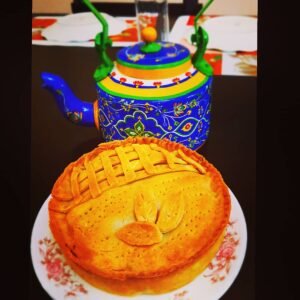
Biryani versus Pulao? An Axomiya Muslim Perspective
“The Muslims in Assam are Assamese in their habits, and Muhammadans but only in name.” – Sir Edward Gait (1906)
A substantial amount of scholarship has corroborated the fact that the Muslims are not a monolith. However, there are few categories of Muslims who have not had a specific religious trajectory of growth but more of a socio-cultural evolution. Such communities, are principally impacted by the larger community that they exist within and their traditions are rooted in the larger societal culture, instead of an exclusively Islamic one. One such community is that of the Axomiya Muslims of Assam, in India’s Northeast.
Islam had arrived in this part of India around the 13th century, mainly through the Mughals and through some saints, who had entered the region. The community of the Axomiya Muslims was largely formed by the inter-marriage of the Mughal soldiers with the Assamese women and through the conversion of the indigenous Axomiya people, under the influence of saints like Azan Fakir.
Azan Fakir, whose real name was Shah Milan was a 17th century Muslim preacher who is credited with the methodical promulgation of Islam in the region especially through his zikirs, which he composed in the local language through which he acquainted the people with the teachings of the Quran and the Hadiths (Dasgupta, 2003). Thus, the influence of culture remained predominant over religion.
Growing up in Assam, as an Axomiya[1] being Muslim has been one of the things I specifically take pride in. Mainly because, the Axomiya Muslims have always been Axomiya first and Muslims only later. This being said, the fact that Muslims are not a monolith applies in this context as well, as there are different categories of Muslims in Assam; I am, however, talking about the khilonjia[2] Axomiya Muslims, which again is quite a contested debate. The Axomiya Muslims make an intriguing category for study because they do not fit the popular and social imageries of the quintessential Muslim in their typical attires, lifestyles and food habits.
In Assam, it is extremely difficult to distinguish an Axomiya Muslim from an Axomiya Hindu because there is no overt distinctiveness in their appearance, clothing, language and food habits. But we have to add in here that there is a difference between the Axomiya Muslims and the Muslims of Assam. The Muslims of Assam include all Muslims within Assam, who may not be Axomiya but may largely identify as Assamese.
The Axomiya Muslims make such an interesting subject because of their ‘open and accommodative’[3] character. The way they have adapted and moulded into the larger Axomiya way of life. It would be easy to illustrate this sameness with the example of food habits and cuisine. For instance, in a north Indian Muslim household the meals would largely be meat dishes and some kind of bread(roti) or rice. Among the Axomiya Muslims, however, the cuisine is largely an adaptation of the Axomiya Hindu food habits and are built around them.
In an Axomiya Muslim home it would be almost typical to find xando guri[4] for breakfast on a daily moring, masor tenga[5] on a warm sunny afternoon and jaluk dia xaahor mangkhor jul[6]on a cozy winter night for dinner. It is also common to find chicken stew kinds of dishes cooked with gourd and there are certain items like koni dhan[7], which are peculiar to the region.
These dishes are essentially Axomiya in character and essence, in the sense that they are common among the Axomiya Hindu society. They are also Axomiya because these dishes had emerged because of the geography, flora and fauna and the climatic conditions of the region. For instance, Assam is a humid area and there is an abundance of rivers and streams in the region; given such conditions fish and fish dishes like the aforementioned masor tenga form a staple favourite for the people here. Again, because of the humidity and abundant rainfall, the Northeast of India provides fertile lands for massive rice cultivation. As such, rice and rice products, like xando and pitha, feature as common snacks and breakfast items for the Axomiya people.
This brings us to the understanding that the cuisine and culinary habits of the Axomiya Muslims are quite different from the pan-Islamic food culture, which essentially comprises rich diets made of meats, breads, and other dishes inherently associated with Muslims in South Asia like biryani[8]. This again forms another interesting aspect about the Axomiya Muslims and their dissociation with the biryani.
On a personal level, I have been asked quite a few times by friends and acquaintances if I would invite them over for biryani on Eid. Though I don’t tend to tell them every time, the surprising part here is that, most Muslims here in Assam, do not prepare biryani on Eid. Neither biryani nor sheer khurma[9] are parts of the Axomiya Muslim Eid celebrations. We here in this part of the country prepare pulao [10]and korma[11] along with other dishes, which are more of an eclectic representation of the multicultural influence on the region and it’s Muslims. I can speak for myself and a few of my friends and cousins, that on Eid we do prepare dishes like baked fish, chicken roast, potato salad/ sprouts salad, and desserts like caramel pudding, date cakes, biscuit pudding or chocolate cakes etc.
Even the dishes, which are essentially interpreted as having a Muslim origin, like kebabs and koftas are prepared slightly differently here. The phirni[12], which is typically prepared with semolina and milk, is made with rice flour and milk in Assam. Bonojit Hussain, researcher and culinary enthusiast opines that the invention of “Assamese Muslim Cuisine is an ongoing discursive practise, an imaginary term serving the anxities of self-identification and otherisation.” [13] This very well reflects the variety of cuisines developed and accomodated by the Axomiya Muslims that further depicts the distinctive culture of the community.

The biryani, again, is not native or common among the Axomiya Muslim households, it is instead pulao and korma for us. Any special occasion would call for it. Also, besides these two dishes it will not be wrong to say that there are no staple items, which essentially feature on the Eid menu.(repetition) Plus, the rice used for the preparation of this pulao is not the commonly used basmati rice but instead, another variety of rice unique to Assam, which is called joha rice. This rice has a wonderfully fragrant aroma, which lends a unique savoury quality to the dish.

‘Pulao’ served at the author’s home. Picture Credit- Dr Sabrina Iqbal
Thus, the fact that the biryani is actually alien to Muslims here can be a rather striking observation given the fact that biryani is largely considered as a part of Muslim cuisine.
The gastronomic specialties of a community help us to understand it in greater depth and give us a holistic picture of the food culture and lifestyle of the same. It would be worth adding in here that even beef does not feature as a predominant or common part of the food habits of the Axomiya Muslims. Given that the Axomiya Muslims are a liberal community, one may find few who even eat pork without inhibitions.
To conclude, let’s just say that even though we are so frequently associated with the biryani, for us our pulao-korma shall always reign supreme. So if it’s biryani versus pulao, pulao wins for us every time!
[1] The indigenous term for the native Assamese Muslims
[2] Assamese word for indigenous
[3] Anindita Dasgupta in Imtiaz Ahmed’s Divorce and Marriage Among the Muslims in India, 2003, Manohar Publishers
[4] Powdered rice typically eaten with milk or warm water as a porridge
[5] Assamese dish of tangy fish curry made with tomatoes, tamarind or lemon or any other sour element.
[6] Duck curry made with black pepper
[7] A kind of grain usually used for desserts
[8] A rich rice dish made by combining layers of rice and meat and other condiments, along with fried onions, ghee, and cooked in a particular style by sealing the lid of the dish with flour dough.
[9] Vermicelli pudding prepared with milk, sugar and a variety of dry fruits.
[10] Rice dish made with caramelized onions and other condiments.
[11] Chicken dish made with yogurt, ginger, garlic and onions, cooked over a low flame.
[12] Dessert made with milk, sugar and semolina
[13] Rini Barman, The Myth of Asamese Muslim Cuisine, 28th October 2016, https://www.thehindubusinessline.com/blink/cover/the-myth-of-assamese-muslim-cuisine/article9276863.ece
(The views expressed in this article are the author’s own. Content can be used with due credit to the author and to ‘Zariya: Women’s Alliance for Dignity and Equality)

Dr. Sabrina Iqbal Sircar, is a feminist, educator, writer, editor and public speaker. Presently, she is Assistant Professor, Department of Political Science, Pragjyotish College Guwahati. She was former coordinator for P.G. Course, Krishna Kanta Handique State Open University, Guwahati, Assam. She was also given the Iconic Women Creating A Better World For all award by the All Ladies League and Women’s Economic Forum, in February, 2018.
Dr. Sircar has had a brilliant academic record throughout. She has been teaching at the university level for the last 10 years.She completed her PhD from Gauhati University and her thesis is titled – The Muslim Family in an emerging Urban Space: A Study of Axomiya Muslims. She is working on women’s issues and, is particularly interested in working on Islamic feminism.



